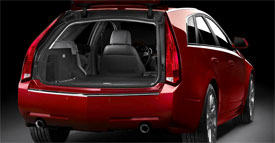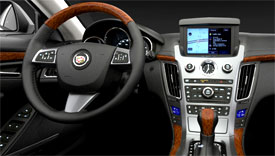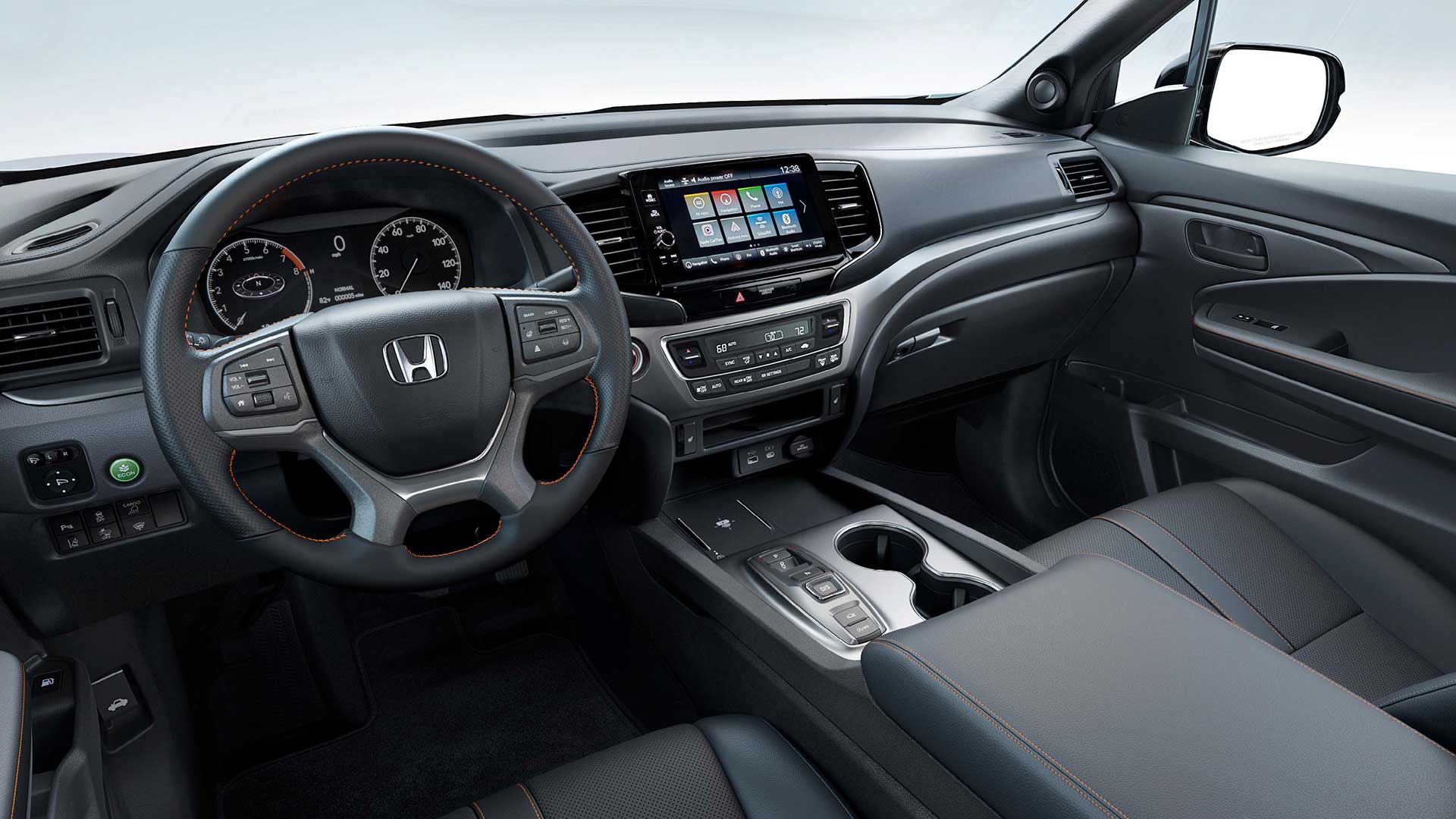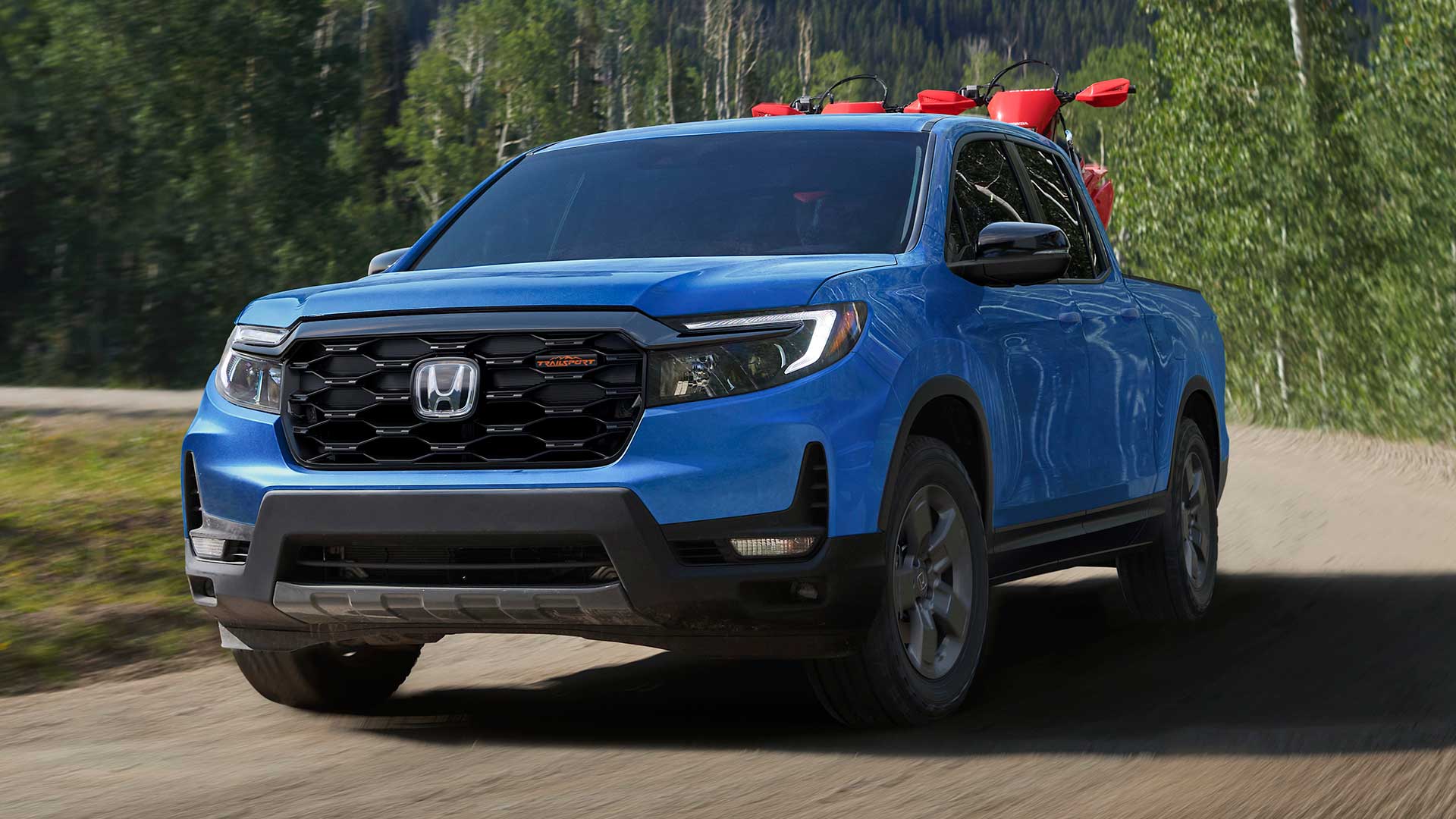2010 Cadillac CTS Sport Wagon
For almost a decade, Cadillac has been on a mission to change its image from mature-posh to Euro-chic. Their main weapon has been the mid-size CTS sedan. Well, with the CTS now firmly rooted as the best sport sedan ever made by an American brand, it’s time for Cadillac to do what a European brand would do, and build on success. This is the CTS Sportwagon-and it’s not just a way to get groceries fast!
The second generation Cadillac CTS bowed for 2008 with classic European sport sedan proportions and the most pleasing rendition yet of Cadillac’s angular “Art & Science” design language. That language is now extended to the 2010 CTS Sport Wagon. Riding on the same 113.4-inch wheelbase, the 5-door is in fact a third of an inch shorter overall than the 4-door at 191.3 inches.
The CTS’ big, confident grille, headlights, and tasteful fender ports carry over unchanged from the sedan. But the Wagon’s chrome-rimmed greenhouse gives its flanks a sporty, going-fast-standing-still character that is distinct from the sedan’s, jetting rearward into a substantial D-pillar. Angular vertical taillights rise above a near flush rear bumper, looking remarkably like fins. The CTS Sport Wagon grabs the pavement with low-profile rubber wrapped around 17-, 18-, or our car’s 19-inch alloy wheels.
 Like the sedan, the wagon’s interior is refined, sporty, and luxurious. The CTS has the richest interior design yet from GM. The big, serious motorcycle-style gauges remain, as does the tilt/telescoping wheel. Sophisticated center stack controls continue to fall pleasantly to hand. OnStar is standard, while optional is an 8-inch nav system with 3D imaging that rises out of the center dash. Also rising to the top is the available panoramic sunroof.
Like the sedan, the wagon’s interior is refined, sporty, and luxurious. The CTS has the richest interior design yet from GM. The big, serious motorcycle-style gauges remain, as does the tilt/telescoping wheel. Sophisticated center stack controls continue to fall pleasantly to hand. OnStar is standard, while optional is an 8-inch nav system with 3D imaging that rises out of the center dash. Also rising to the top is the available panoramic sunroof.
While BMW-like leatherette upholstery is standard, our car sported leather-trimmed buckets with French stitching. But their thin design also made them rigid and hard. Meanwhile, true to the European sport sedan and wagon formulas, rear seat legroom is tight.
But raise the standard power hatch and you’ll find a long, flat cargo floor complete with adjustable tie-down clips on rails. Pull up the floor panel and there’s hidden storage underneath. Cargo space measures 25 cubic feet seats up, with a center pass-through for long, skinny items. Folding the 60/40 rear seats yield a cavernous 53.4 cubic feet. That’s almost four times the CTS sedan’s trunk space.
A new all-aluminum 3.0-liter, 270-horsepower direct-injected V6 replaces the CTS’ previous base 3.6-liter port-fuel-injected V6. The new engine has both more power and higher fuel economy. Optional is our car’s direct-injected 3.6-liter V6, with the same stout 304 horsepower and 273 pound-feet of torque as the sedan.
Government fuel economy ratings for the rear drive 3.6-liter Sport Wagon are 18 city, 26 highway on regular gas, but all we managed was a rather disappointing 19.2 miles per gallon in mixed driving. The CTS’ Energy Impact Score of 16.3 barrels of oil a year and 8.7-ton Carbon Footprint match the Audi A6 Avant’s scores exactly.
A six-speed automatic with available paddle shifters is the Sport Wagon’s sole transmission. All-wheel-drive is also an option on the wagon, but ours invested all of its powers in the rear wheels with a limited-slip differential.
At the track, the Sport Wagon jogged to 60 in 7.2 seconds and through the quarter mile in 15.5 seconds at 93 miles per hour. Slow, deliberate shifts softened power delivery.
 Vented disc brakes with ABS and Brake Assist reside at each corner. They ground out average stops of 112 feet from 60 to 0, which is outstanding. Braking is a much sportier experience than acceleration, with fine stability, but more-than-expected nose dive.
Vented disc brakes with ABS and Brake Assist reside at each corner. They ground out average stops of 112 feet from 60 to 0, which is outstanding. Braking is a much sportier experience than acceleration, with fine stability, but more-than-expected nose dive.
Handling prowess depends on your choice of three suspension setups. The softest is designated FE1, which delivers a more traditional Cadillac ride. FE2 is significantly sportier, while the aggressive FE3 with load leveling is the stiffest. It transmits every road ripple back to the driver, but also delivers ultra-sharp handing that rivals Europe’s best.
Pricing for the CTS Sport Wagon starts at $40,655. All-wheel drive adds $1,900 more. Add the bigger engine, Nav, and sunroof and you’re well over 50 grand.
The 2010 Cadillac CTS Sport Wagon offers great style and serious versatility, yet retains all the athletic prowess of the CTS Sedan. That’s an impressive resume for any car of any shape, and it’s another step towards Cadillac emulating the best luxury sport brands from Europe. While many enthusiasts will resist any sporty car with a square back, the CTS Sport Wagon really is having your sport sedan and room for a wedding cake too.
Specifications
- Engine: Direct-injected 3.6-Liter V6
- Horsepower: 304
- Torque: 273 Lb Feet
- 0-60 MPH: 7.2 Seconds
- 1/4 Mile: 15.5 Seconds @ 93 MPH
- 60-0 MPH: 112 Feet
- EPA: 18 MPG City/ 26 MPG Highway
- Mixed Loop: 19.2 MPG
- Energy Impact: 16.3 Barrels Oil/Yr
- CO2 Emissions: 8.7 Tons/Yr
2024 Honda Ridgeline TrailSport
It Does Truck-Like Things Better Than Ever
Honda brought something truly unique to the pickup truck scene when their mid-size Ridgeline debuted for 2006. In 2017, it moved towards becoming a little more true truck-like, both in form and capability, now with yet another step in that direction for 2024. So, let’s see if the Ridgeline is really hitting its stride.
For 2024, it’s all about making this Honda Ridgeline better than ever. There are styling tweaks outside, along with tech and functional improvements inside, but the biggest news is the Ridgeline has now joined Honda’s TrailSport family of off-road inspired vehicles. This more-true-trucklike, second-gen Ridgeline been around since 2017, receiving periodic updates over the years; but joining the TrailSport family is the biggest leap yet.
Primarily, the TrailSport transformation includes General Grabber all-terrain tires, mounted on new Pewter Gray 18-inch wheels, steel underbody protection, and retuning the strut front, and multi-link rear suspension for added wheel articulation. And while we always appreciate the additional traction of off-road tires, the Ridgeline’s standard i-VTM4 all-wheel drive, with Intelligent Traction Management and snow, sand, and mud settings, was already quite capable of handling all but the most extreme off-roading, ground clearance of just 7.6 inches being it’s only real hinderance.
A 3.5-liter V6 remains under the hood as it has since the Ridgeline debuted for 2006; the current version outputs 280 horsepower and 262 lb-ft of torque, plenty enough muscle to handle its 5,000-lbs. towing capacity. A nine-speed automatic transmission with paddle shifters and bevy of push and pull buttons on the console replaced the six-speed automatic back in 2020.
In addition to adding TrailSport capability, a big focus for this update was making it more user-friendly inside, starting with the central touchscreen growing from 8 to 9 inches. It also gets faster processing speeds, menus have been simplified, and the native navigation system is improved with better graphics. It’s accompanied by a new digital instrument cluster, along with an upgraded center console with more storage space. Unique TrailSport touches include heavy duty floormats, leather-trimmed seats, orange stitching throughout the cabin, and orange ambient lighting.
The Ridgeline continues to offer things available nowhere else in the pickup truck market.
Exterior styling doesn’t exactly shout “macho big rig coming your way,” but the more vertical face and larger grille that arrived for 2021, along with this year’s added TrailSport elements, do continue to toughen up the Ridgeline’s image. The 5’4” bed remains highly functional with no large wheel well intrusions, multiple tie-downs points, lighting and even speakers. And of course, the Ridgeline continues to offer things available nowhere else in the pickup truck market, like the dual-action tailgate, and large, lockable, drainable, underbed storage. Not to mention being able to drive around in true car-like comfort, something we took full advantage of on our way to our Mason Dixon Dragway test track.
There was great grip off the line, with full power arriving smoothly but quickly, helping us to get to 60 in 7.0 seconds flat, a tenth quicker than the last Ridgeline we tested. That power delivery stayed fairly consistent the whole way down the track, barely interrupted by the nine-speed automatic’s smooth shifting. Our best quarter-mile run was 15.5 seconds at 90 mph.

The revised suspension and knobbier tires didn’t really seem to add or detract from handling prowess, as it felt as solid, nimble, and car-like as it always has through our cone course. Perhaps a little less stiff than before, but good feedback, tight steering, and minimal body roll for a pickup, made for a very confidence inspiring experience. In our braking test, we stopped in a respectable average of 123 feet from 60, with only moderate amounts of nosedive and good feel through the pedal.
There is, however, a slight reduction in Government Fuel Economy Ratings with the all-terrain tires; 18-City, 23-Highway, and 20-Combined, our average, right on, at 20.4 mpg of Regular. That’s a slightly below average Energy Impact Score of 14.9 barrels of yearly oil use, with CO2 emissions of 7.4 tons.
TrailSport pricing falls in line just under the Ridgeline’s top Black Edition trim with a starting price of $46,375, about five grand over a base Ridgeline Sport.
So, whether you consider the Honda Ridgeline to be a “real” truck or not, this ruggedly smooth 2024 TrailSport does truck-like things better than ever. And we’re not just talking about the slight upgrade in off-road performance, we’re talking about a flexible bed to help you get chores done, and the ability to tow or haul with comfort and flexibility other trucks can only wish for. It’s why the Ridgeline brings more first-time buyers to Honda than any other vehicle, and why it continues to be a great choice in the growing midsize truck realm.
Specifications
- Engine: 3.5-liter V6
- Transmission: 9-speed automatic
- Horsepower: 280
- Torque: 262 lb-ft
- EPA: 18 City | 23 Highway | 20 Combined
- 0-60 mph: 7.0 seconds
- 1/4 Mile: 15.5 seconds at 90 mph
- 60-0 Braking (avg): 123 feet
- MW Fuel Economy: 20.4 mpg (Regular)
- Max Towing Capacity: 5,000-lbs









